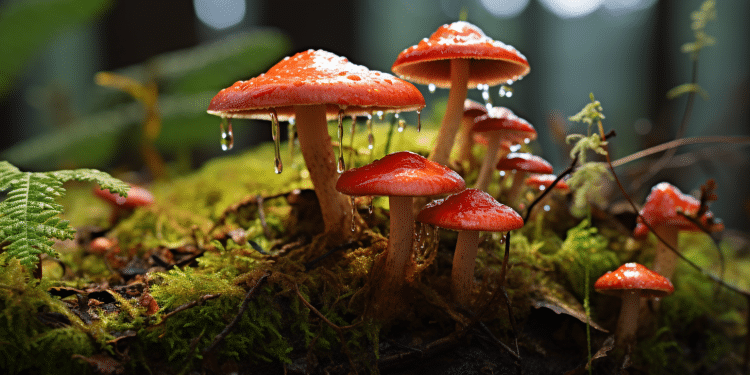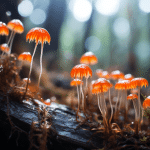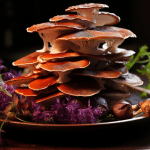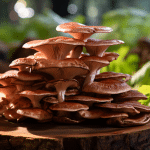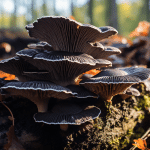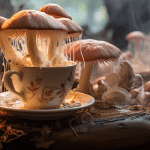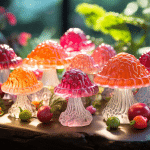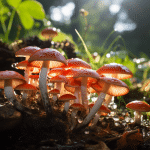If you want to gather reishi mushrooms, you must first understand their physical features.
The name was inspired by the Greek words “ganodos” (meaning bright/shining skin) and “derma.” As you might expect, reishi mushroom caps’ tops are highly polished.
The mature reishi caps are shaped like a clam shell, but the young mushrooms look like brilliant-colored fingers until a cap develops. During maturation, reishi mushrooms develop concentric red, orange, and white rings on the caps. The color of each individual fungus varies depending on species and environmental conditions.
Reishis are not gilled mushrooms. They’re polypores, which means the underside of the cap (where the spores are produced) resembles a tiny-pored sponge with lots of small dots. The surface of a reishi pore is white in color.
Spore print: If you set a reishi mushroom pore-side down, it should produce a brownish-colored spore print in approximately 6+ hours.
Do reishi mushrooms have poisonous lookalikes?
There are no poisonous look-alikes to reishi mushrooms in North America. The red belted conk (Fomitopsis pinicola) is a reishi lookalike that isn’t harmful.
Reishi Mushroom Look-alikes
Because all reishi mushrooms are often the same appearance and share similar health benefits, it does not provide significant value to know what particular species of reishi mushrooms you possess. As long as you can tell that it is a reishi mushroom, that is enough.
Unless you are studying them for scholarly purposes, you can use all the reishi mushrooms for their medicinal benefits. However, you will want to avoid any other mushrooms that just so happen to resemble reishi mushrooms. While there are no toxic look-alikes to be concerned with while searching for reishi, you don’t want to put in the effort of collecting and drying mushrooms that are non-medicinal, offering no health benefits.
It may appear a lot like a reishi, as it grows out in rings, with red in the middle and lightening up to white at the edges. You can tell a reishi apart from the red ribcage clefts by scratching its underside. A reishi mushrooms will bruise under the pores when scratched, while the red belted conk does not.
You can also make spore prints to tell them apart, if you are still not sure. A Red Belt Conk has a white or yellowish spore print, whereas Reishi mushrooms leave a darker, brownish spore print.

It is worth noting that the red belted conk has also been found to be of medicinal value, having been used by Native Americans in traditional times. So, even if you happen to pick it up and eat it, it still has some benefits.
Are Reishi Mushrooms Rare?
Reishi mushrooms are not uncommon, but finding them in the wild may be challenging because they generally grow high up on trees and their tiny size makes them hard to detect. If you do spot any, it’s preferable to keep the majority of them so that the population can grow.
What Do Reishi Mushrooms Look Like?
Reishi may be one of the easiest mushrooms to identify, as they usually look pretty distinctive. If you see a shelf mushroom that has a deep red body, with colors lightening up to orange, yellow, and white towards the edges of the cap, you can rest assured you are looking at a Reishi. Reishi mushrooms are a species of shelf mushroom you may find growing horizontally from tree trunks. They have no obvious stems, unlike mushrooms growing from the ground. Older specimens can turn a brownish color, making them harder to identify.
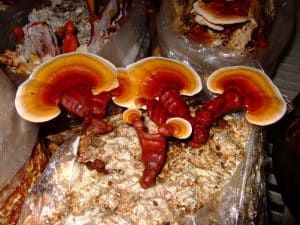
However, there scalloped caps, with rings resembling trees at the top, are quite a good clue. There are no toxic mushrooms like Reishi mushrooms, so these are a good one to try for beginners too. The worst-case scenario is you will get a similar-looking mushroom that provides lots of additional fiber in your diet, but has no actual medicinal benefits.
You can find our favorite capsules, powders, and tincture’s on the following pages of our website and learn more about each individually:
Best Reishi Mushroom Supplement
Best Reishi Mushroom Mushroom Gummies
Additional Resources:
Are Reishi Mushrooms Nootropic?
Can Reishi Mushroom Cure Diabetes?
Updated 10/19/2022
